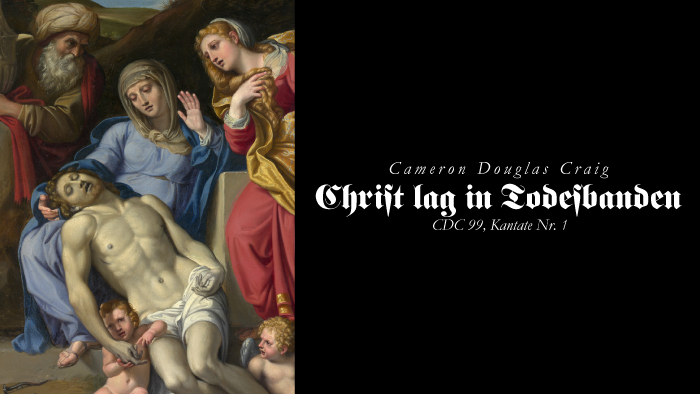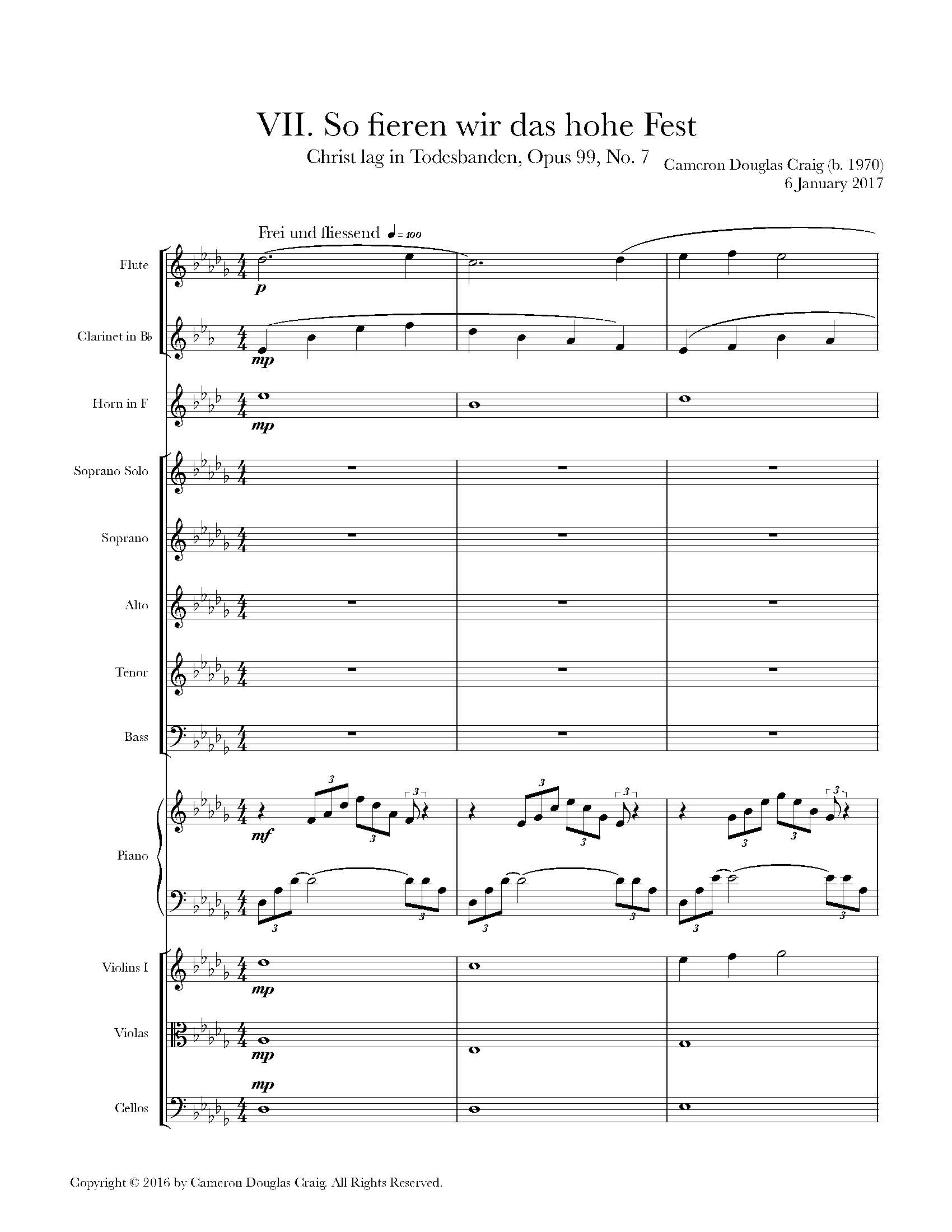tcpfilms » arts » cdc » christ lag in todesbanden

Christ lag in Todesbanden, CDC 99, Kantate Nr. 1
Cameron Douglas Craig
Copyright © 2016-2017 by Cameron Douglas Craig.
All Rights Reserved.
The Work
English Translation (1854) |
Original German Hymn (1524) |
| from Richard Massie, "Martin Luther's Spiritual Songs" | from Martin Luther |
I. Symphony |
I. Sinfonia |
II. Verse 1 |
II. Versus 1 |
III. Verse 2 |
III. Versus 2 |
IV. Verse 3 |
IV. Versus 3 |
V. Verse 4 |
V. Versus 4 |
VI. Verse 5 |
VI. Versus 5 |
VII. Verse 6 |
VII. Versus 6 |
VIII. Verse 7 |
VIII. Versus 7 |
![]()
CDC's Personal Notes on "Christ lag in Todesbanden"
Cameron Douglas Craig
24 July 2017
 After completing six of the eight movements of my cantata between December 22, 2016 and January 6, 2017, I finally completed the last two movements (six and eight) on July 20 and 21, 2017. What a journey it has been to take words of special meaning and set them to music. It has been an emotional venture to say the least and I am extremely excited to provide a spiritual journey through the death and ascension of Christ in this new work of mine.
After completing six of the eight movements of my cantata between December 22, 2016 and January 6, 2017, I finally completed the last two movements (six and eight) on July 20 and 21, 2017. What a journey it has been to take words of special meaning and set them to music. It has been an emotional venture to say the least and I am extremely excited to provide a spiritual journey through the death and ascension of Christ in this new work of mine.
The text from "Christ lag in Todesbanden" is from Martin Luther for which he wrote the seven verses describing the death and ascension of Christ. After learning about the work set by J.S. Bach, I was intrigued by the text and wanted to put my personal emotional musical spin, so to speak, on the text. Excitedly inspired by the words written by Luther, I began working on the music just a couple of days before Christmas.
The first movement I began working on was verse three (mvmt four). The words struck me as clear as a bell and I felt the emotional chill of the sacrifice Christ gave to all of humanity. The movement is written for the solo tenor with clarinet wrapped around the theme. At particular points the chorus emphasize the statement that Christ gave up his rights and power for us. This emotional journey is emphatic but ends with a sense of hope and thoughtful appreciation of the sacrifice he gave for future generations.
At the beginning of the project, I was struggling with how to begin the complete work. The symphony or "sinfonia" was next. In my mind, I pictured the scene on Calvary with the three crucified souls. As Christ was grasping for life with each breath, I attempted to put myself in his place with the extreme pain and the endless questions that plagued His mind. The symphony begins with uncertainty in the consistent suspensions with each measure. After the initial discombobulated theme concludes, we are taken through another series of suspensions that are more appealing to the listener. The musical evolution paints a picture of gentle understanding of the ultimate task Christ has been given by his Father. In the continued time line, the moment shifts to the question of "why?" The answer is given in a much slower reiteration of the original theme that focuses on the spiritual reasons behind Christ's ultimate gift of his life...The forgiveness of our sins. The last note of the clarinet presents its self as a question. The question is directed to the listener. It is not directly answered but requires the listen to determine what emotion he or she feels should be the answer.
Sitting at my original piano at my childhood home for the Christmas holiday, I continued to write music for the second movement of the work that would be the first verse of Luther's hymn. "Christ lag in Todesbanden" was very exciting to write because it begins very morbid but yields a certain relief in happiness near its conclusion. The transformation caused my eyes to fill with tears at the change from the idea of Christ's death to the beauty of the sacrifice he made in that death.
The next verse, the second (mvmt 3), was a new style of writing of mine that I was excited to debut with this work. The verse is written as a duet with soprano and mezzo soprano. Beginning with a clarinet solo there is a sense of urgency in this movement. The words describe the continued idea that we have no idea what death is like. It humbles us and forces us to understand Christ's bondage as a human so that we appreciate the sacrifice he gave each of us. The music has an emphatic character to it with the sternness of female voices providing that serious character of death. The French horn and clarinet near the end suggests a call to humanity.
The next movement that I began was, in fact, a major struggle. How am I to present the "Sting of Death?" Although this particular movement presented a few uncertainties in the writing, the one word that I centered the theme around was "Krieg." In English, it is "war." In this context, what was the "war?" The "war," in my mind, was the battle between life and death. It is given to us as an example of the struggle to want to live a full life but to be forced to make the ultimate sacrifice to save others. Christ made that sacrifice and sometimes we take it for granted. Luther provides us with a meaning of Christ's death and struggle to provide us with life...everlasting life.
There are three movements that are personal favorites...Seven, Six, and Eight. The seventh was written at my childhood home and would be the last to be written at home for this cantata. "So fieren wir das hohe Fest" is translated as "So let us keep the festival." Of all the movements in the order of the pieces of the cantata thus far, it is the most beautiful and tranquil. The music gives us a sense that the sunlight we experience each and everyday is a continuous fact. Christ's love and ultimate sacrifice to us is the same. It is ever continuous and flows through each of us.
The sixth movement was toyed with for several months. I was unsure of its theme and direction. Eventually, I decided on a very calming cycle or canon that was a comforting emotion in music. The music begins as a calming and tranquil feeling but then when the discussion turns toward the Devil, there is a shift in the intensity of the music. However, we return to tranquility which is why Christ died for us.
The final movement, "Wir essen und leben wohl," has two different versions. The first version contains a theme written two decades ago. Although it is very appealing, it really never fit in my mind. The newest version really excited me and resulted in an emotional finale. The movement begins with a recapitulation of the theme from the second movement and then flows into a new theme that evolves as a cycle...never really ending (it could very well go forever). After a flowing statement that describes the communion, the return of the original theme from the second movement become ever more prominent and most emphatic in a way that it will force us to remember the ultimate sacrifice Christ gave us so that we would have everlasting life with Him.
Although the actual writing of the cantata took several weeks, the journey toward its completion lasted just over six months. The venture has been rewarding in that I am extremely pleased of the result. Writing the pieces both at home and in my new home church in Charleston, Illinois, I am thankful for the talent given me. This work is probably my most favorite because of the emotional message it provided me and will provide the listener in time.

